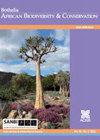偷猎对南非濒危物种欧金马氏脑甲种群结构及昆虫类群的影响
IF 0.5
4区 生物学
Q4 PLANT SCIENCES
引用次数: 0
摘要
背景:南非是非洲重要的苏铁多样性中心,然而,该国的苏铁面临灭绝。其中一个主要原因是偷猎野生植物,甚至在保护区内也是如此。目的:本研究调查了当地濒危物种金马氏脑象种群的偷猎模式。以及它如何影响种群结构、性别比例,以及与相关昆虫的相互作用。方法:2008年对该人群进行调查,2021 - 2022年对40%的人群进行再调查。我们绘制了缺失的苏铁,并生成了热图。最后,我们调查了不同大小类别的茎的比例、性别比例和昆虫同伴的丰度在高偷猎率和低偷猎率地区之间是否存在差异。结果:偷猎(定义为非法将个体从野外移走)在边境围栏沿线发生的频率是其他地区的1.5倍。中型茎(21-80厘米)是主要目标(可能是因为它们更容易携带),在偷猎发生率高的地区,这些茎的比例很低。虽然E. eugene-maraisii通过基部吸吮表现出一定的抵御偷猎的能力,但吸吮体需要几十年的时间才能成熟并替换采伐的茎。在高偷猎发生率的地区,没有记录到对性别比例的影响,这表明偷猎者并没有故意在这个地点选择雌性或雄性苏铁。未发现传粉昆虫,未观察到苗木。结论:在减少的种群中,球果生产可能过于稀少,无法支持传粉者利用球果作为产卵地点。在更大的种群中,使用其他植物部分(包括叶子、干叶柄和苏铁树干)的昆虫的存在表明,它们对宿主种群减少的适应能力更强。然而,这些昆虫在较小的种群中是不存在的,在低密度地点它们的丰度较低,在较大的种群中它们的寄主的簇大小较小。这表明,由于偷猎,这些昆虫可能很容易受到寄主数量下降的影响。本文章由计算机程序翻译,如有差异,请以英文原文为准。
Impact of poaching on the population structure and insect associates of the Endangered Encephalartos eugene-maraisii from South Africa
Background: South Africa is an important centre of cycad diversity in Africa, however, the country’s cycads face extinction. Among the primary causes is the poaching of plants from the wild, even within protected areas. Objectives: This study examined poaching patterns in a local population of the Endangered Encephalartos eugene-maraisii I.Verd. and how it might affect the population structure, sex ratios, as well as interactions with associated insects. Methods: The population was surveyed in 2008 and 40% of this population was resurveyed between 2021 and 2022. We mapped missing cycads and generated heatmaps. Lastly, we investigated whether the proportion of stems from different size classes, sex ratios and abundance of insect associates varied between areas with a high and low poaching incidence. Results: Poaching, defined as the illegal removal of individuals from the wild, occurred 1.5 times more frequently along the border fence line than areas further away. Medium-sized stems (21–80 cm) are primarily targeted (likely as they can be carried more easily) and low proportions of these stems remain in areas with a high poaching incidence. While E. eugene-maraisii exhibits some resilience against poaching through basal suckering, it takes several decades for suckers to mature and replace harvested stems. No effect on sex ratios were recorded in areas with a high poaching incidence, suggesting poachers have not deliberately selected female or male cycads at this site. No pollinating insects were detected on E. eugene-maraisii, and no seedlings were observed. Conclusion: Cone production may be too rare in diminished populations to support pollinators that utilise cones as brood sites. The presence of insects that use other plant parts, including leaves, dried leaf stalks and cycad trunks, in the larger population suggests that they are more resilient to diminishing host populations. However, these insects were absent in smaller populations, and their abundances were lower in low-density sites and smaller clump sizes of their host in the larger population. This suggests these insects may be vulnerable to the decline of their host populations due to poaching.
求助全文
通过发布文献求助,成功后即可免费获取论文全文。
去求助
来源期刊

Bothalia
生物-植物科学
CiteScore
1.70
自引率
0.00%
发文量
12
期刊介绍:
Bothalia: African Biodiversity & Conservation is published by AOSIS for the South African National Biodiversity Institute (SANBI) and aims to disseminate knowledge, information and innovative approaches that promote and enhance the wise use and management of biodiversity in order to sustain the systems and species that support and benefit the people of Africa.
The journal was previously published as Bothalia, and had served the South African botanical community since 1921. However the expanded mandate of SANBI necessitated a broader scope for the journal, and in 2014, the subtitle, African Biodiversity & Conservation was added to reflect this change.
 求助内容:
求助内容: 应助结果提醒方式:
应助结果提醒方式:


